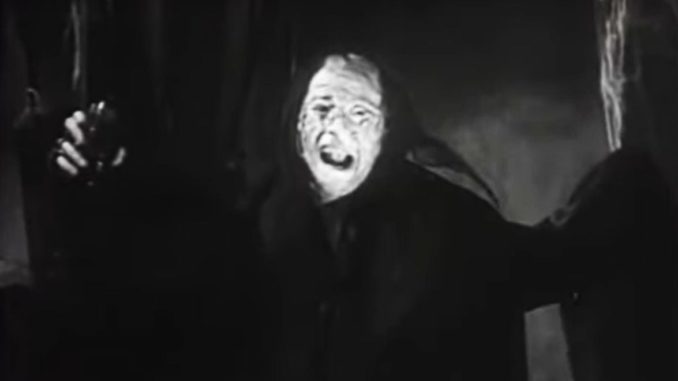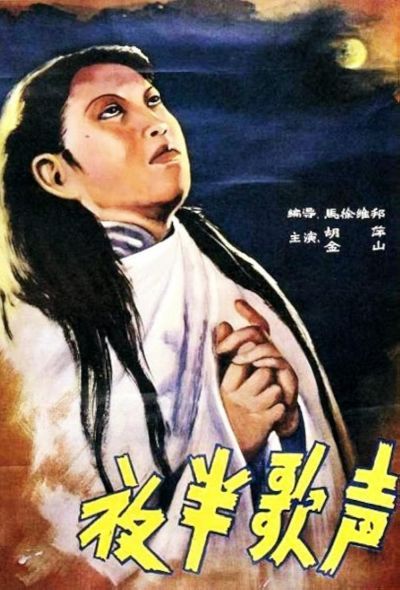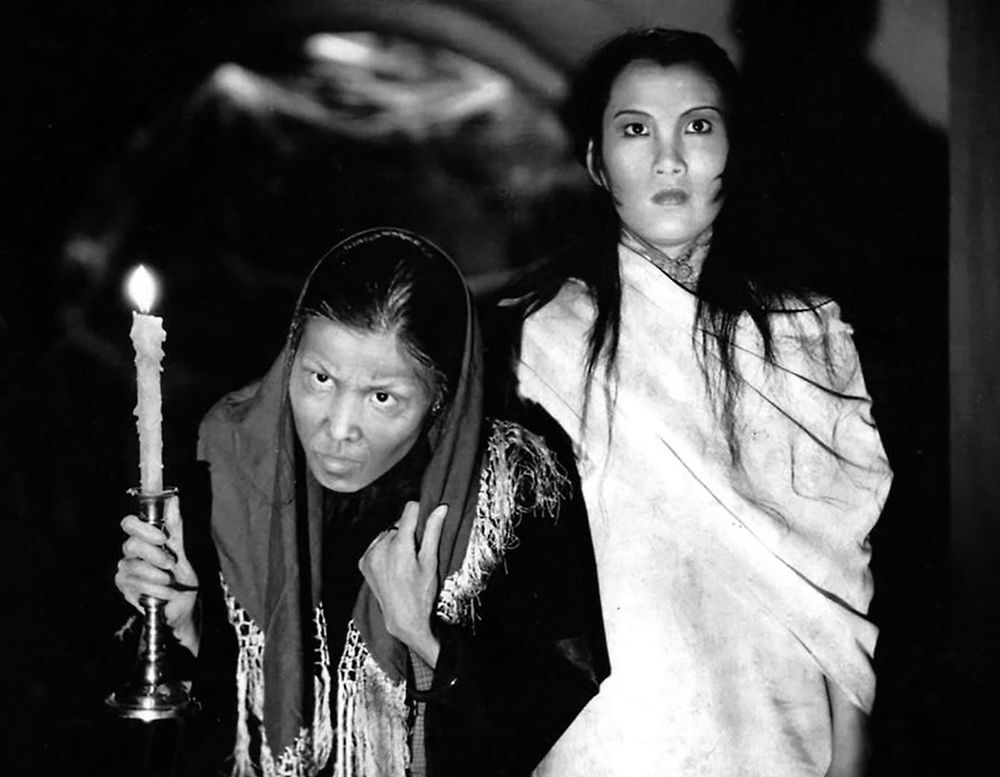
Rating: C+
Dir: Ma-Xu Weithbang
Star: Jin Shan, Gu Menghe, Shi Chao, Hu Ping
China and Hong Kong have become one of the richest veins of horror I’ve mined in my time as a genre fan. It began for me with things like A Chinese Ghost Story, in the eighties, and continues to this day – albeit with less culturally ostentatious fare, typically involving, oh, killer sharks and snakes. This is often regarded as the first Chinese horror movie, and it was therefore something of a surprise that the country did not start of by mining its own history of legends and folklore. Instead, this is largely the first sound adaptation of Gaston Leroux’s novel, The Phantom of the Opera, already brought successfully to the screen through Lon Chaney’s silent version, made in 1925.
The core story is clearly the same, though the “phantom”, opera singer Song Danping (Jin), is not born disfigured. Instead, he became horribly scarred in an acid attack, resulting from a battle with the cruel Tang Jun (Gu), for the affections of Li Xiaoxia (Hu). Danping fakes his death and takes up residence in the opera house attic, but is convinced to help young actor Sun Xiao’ou (Shi) become a star. This is a notable difference from the Western version, where the “Phantom” tutors a young woman. Things then continue to go their own way, with Tang Jun returning, and setting his sights on Xiao’ou’s girlfriend. This sets the stage – more or less literally – for the confrontation you would expect, between Tang and Song.
 This came out during a fraught time in China, just a few months before the beginning of the war with Japan, in which millions of Chinese died. There’s certainly political angles here, with Song having been a revolutionary fighter before having to invent a new identity, taking his talents to the theatre. Mind you, I’m not sure I’d go quite as far as some analyses. Per Wikipedia, “Danping’s scar becomes the mark of the historic battle between feudal and revolutionary forces. Insofar as the facial deformity signals its bearer’s sacrifice and the reality of his struggle, the scar is an icon of ideological virtue.” For obvious reasons, I’m just here for the horror. And the songs, this also potentially being the first film to combine terror and songs.
This came out during a fraught time in China, just a few months before the beginning of the war with Japan, in which millions of Chinese died. There’s certainly political angles here, with Song having been a revolutionary fighter before having to invent a new identity, taking his talents to the theatre. Mind you, I’m not sure I’d go quite as far as some analyses. Per Wikipedia, “Danping’s scar becomes the mark of the historic battle between feudal and revolutionary forces. Insofar as the facial deformity signals its bearer’s sacrifice and the reality of his struggle, the scar is an icon of ideological virtue.” For obvious reasons, I’m just here for the horror. And the songs, this also potentially being the first film to combine terror and songs.
I will admit, after enduring more than my annual quota of plinky-plonkiness in yesterday’s entry, The Ghost Cat and the Mysterious Shamisen, I was not exactly eagerly looking forward to another entry in the Asian horror-musical sub-genre. However, there are only three musical numbers, so even the show-tune intolerant should not find their patience overtaxed. Jin has quite a good voice, though the tendency of the film to enter Literal Video territory is disconcerting. Danping is singing about running water? Here, have a shot of a stream. Of note is the soundtrack’s fondness for Western songs. It feels as if the makers bought “Your Greatest Classical Tunes, Vol #3”, going by the presence of Night on Bald Mountain, some Debussy, and Gershwin’s Rhapsody in Blue (then relatively contemporary, having been composed in 1924).
There are some impressive moments here, though probably not quite enough to justify a running-time of close to two hours – especially for someone like me, who is uninterested in any political subtext. The reveal of Danping’s scarred visage is well-done, with the horrified reactions of those around him selling it very effectively. The make-up isn’t bad either: he certainly looks like he’s had acid thrown into his face. And when things finally get going, the story seems to go from zero to sixty in about two seconds. You get Tang and Song brawling their way around the theatre, while a mob – complete with torches and pitchforks, or at least whatever is the Chinese version of the latter – follows in their wake. It feels like the director was also influenced by Frankenstein and The Hunchback of Notre Dame.
It’s all rather thrilling, and quite poignant, although the final shot looks like a poster for Tractor Factory Follies of 1937. I would say there seems to be a good deal of slack. For example, there’s a lengthy flashback which gives us the history of Danping. I get the need for this, but it feels like it goes into too much detail, and derails the plot unnecessarily. I think it might have been better if this had played out at the beginning, with a “10 years later” caption, before Sun Xiao’ou and his troupe show up. In the middle, Danping feels like he’s superfluous, lacking the purpose of unrequited love for Christine present in the original. In this version, his girl is off to one side and has gone full Ophelia. It’s only when Tang shows back up, that there’s any real conflict present.
 However, I still enjoyed the film, certainly to a greater degree than Ghost Cat. Although it’s a story with which I’m very familiar [I’ve probably seen the Lloyd-Webber version more than any other stage production], that’s not necessarily a bad thing – especially given subtitling on the print I watched, which left a lot to be desired (that’s on me, admittedly). There’s enough local flavour here to keep things interesting, to the extent it feels like it could be based on a Chinese folk-story. Perhaps spurred on by the national unease of the time, it was a huge hit in China, becoming the most successful domestic production of the year after its release. Its success was helped by imaginative if hyperbolic marketing which included, “an oversized coffin placed outside of a theater, a poster featuring the Phantom’s face with light bulbs for eyes, and rumors that the aforementioned poster had scared a child to death.” William Castle would be proud.
However, I still enjoyed the film, certainly to a greater degree than Ghost Cat. Although it’s a story with which I’m very familiar [I’ve probably seen the Lloyd-Webber version more than any other stage production], that’s not necessarily a bad thing – especially given subtitling on the print I watched, which left a lot to be desired (that’s on me, admittedly). There’s enough local flavour here to keep things interesting, to the extent it feels like it could be based on a Chinese folk-story. Perhaps spurred on by the national unease of the time, it was a huge hit in China, becoming the most successful domestic production of the year after its release. Its success was helped by imaginative if hyperbolic marketing which included, “an oversized coffin placed outside of a theater, a poster featuring the Phantom’s face with light bulbs for eyes, and rumors that the aforementioned poster had scared a child to death.” William Castle would be proud.
Critically, it remains highly regarded, and regularly appears on lists of the top Chinese films. It spawned a sequel, and a number of remakes. The best known of the latter is likely 1995’s The Phantom Lover, directed by Ronnie Yu (Freddy vs. Jason) and starring Leslie Cheung as Danping. But seeing this almost makes me want to turn this into 32 Days of Vintage Horror, just so I could also include Lawton’s version of the story.
This article is part of our October 2025 feature, 31 Days of Vintage Horror.
